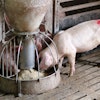
The best response to a mycotoxin challenge includes repairing GI tract damage.
No matter how or when a mycotoxin issue hits, the result for dairy cows is the same. Mycotoxins in feed damage the cow’s gastrointestinal (GI) tract, resulting in:
- Reduced dry matter intake
- Lower feed efficiency
- Decreased disease resistance
- Increased reproductive issues
- Lower milk production
“Mitigating mycotoxins starts in the field with variety selection, anti-fungal treatments and other crop management strategies,” says Stephanie Ward, North Carolina State University assistant professor of animal science and extension dairy specialist.
“But, farmers cannot control the weather. Inevitably, mycotoxins are going to show up in feed,” she adds. “Our data show that feed additives can provide an option for reducing the negative impacts on cow health and milk loss when dealing with mycotoxins such as aflatoxin.”
No dairy farmer wants to experience the performance consequences of mycotoxins, so how do we as nutritionists combat this varied threat? It starts by better understanding the challenge at hand and formulating diets to help defend and repair the GI tract when under insult.
What’s at stake?
As mycotoxins pass through the cow’s digestive system, they attack the tight junction proteins that ensure cell wall integrity in the GI tract. The tight junctions are responsible for keeping pathogens trapped in the GI tract and safely out of the bloodstream, where they can cause infection. This loss of integrity can cause gaps in the gut lining and allow environmental pathogens such as Salmonella, E. coli and campylobacter to escape GI tract containment. Gaps or loss of integrity in the intestinal lining also impact feed efficiency because they interrupt digestion and nutrient uptake.
Gaps or leaks in the gut happen more often when mycotoxin exposure is high, but the impacts of low exposure over time can add up to cause leaky gut, too.
Solving the challenge
The first step in solving a mycotoxin challenge is to identify it. Submit feed samples to a diagnostic lab for accurate, actionable results. If results indicate levels of mycotoxins that could impact animal performance, start working through solutions, which can include:
- Diluting affected feedstuffs with clean feeds to reduce the impact of the mycotoxin challenge
- Feeding a combination of feed additives to support forage hygiene and feed quality, as well as to repair GI tract damage caused by mycotoxin exposure
Mycotoxin levels can change over time in the same feedstuff. Periodic testing can expose varying mycotoxin levels, ranging from manageable to harmful. You will want to have a grasp on these levels at any given time to adjust your game plan.
Using additives to restore balance
Using a strategic blend of multicomponent feed additives, including absorbents, prebiotics and probiotics, can support rumen health and dry matter intake during a mycotoxin challenge. Here’s how they work:
- Absorbents help remove the toxins from the animal.
- Prebiotics feed the gut microbes.
- Probiotics balance the microbe population in the gut.
You can also consider:
- Using lactic acid bacteria promoters, which help balance volatile fatty acid profiles to return the cow’s rumen to normal function and pH balance for optimal nutrient digestibility
- Increasing dietary protein, energy, mineral (Cu, Mn, Zn, Se) and vitamin (A, E, B1) levels to offset gut health challenges and mitigate impacts on cow health and performance
Stay the course
Once the mycotoxin challenge has been corrected and cow milk production and reproduction have improved to pre-challenge levels, it might be tempting to remove feed additives from the ration. However, it’s impossible to know the extent of the GI tract damage mycotoxins caused. You could lose the benefits of the feed additives if you include feed additives for a couple of weeks and then remove them. To keep cows functioning at top levels, maintain the use of feed additives.
In some cases, additives can have a challenge-state feeding rate and normal-state feeding rate. Returning to normal state feeding rates once the challenge has been addressed is recommended. Talk with your supplier to understand the difference in feeding rates, as applicable, and why these adjustments are important.
3 things to ask your feed additive supplier
Adding absorbents, also known as flow agents, to dairy rations is a common strategy to support feed quality and hygiene. The molecules in these products are drawn to the mycotoxin molecules. The molecules combine, and the mycotoxin is no longer able to damage the cell walls of the GI tract.
Absorbents can’t be used interchangeably because each of them is different. Ask your feed additive supplier specific questions to ensure you’re getting the right product for the challenge you are trying to solve. Ask for:
-
Data that demonstrates how the product works effectively at different pH ranges.
Why: The pH in the rumen and the small intestine are different. Be sure the product you choose works where you want it to within the cow’s digestive system.
-
Data demonstrating the product’s effectiveness against a variety of toxins.
Why: Absorbents are not interchangeable. If you are addressing a combination of four mycotoxins, and your absorbent is only chemically responsive to two of them, you’re not going to solve the challenge.
-
The feeding rate for each ingredient if the product is a blend.
Why: A blend of absorbents may help address a variety of toxins, but the mixing rate must be based on the individual ingredient – not the blend. For example, consider a product with two ingredients. Ingredient A and Ingredient B are each effective when mixed at 5 pounds per ton. If you formulate the blend at 5 pounds per ton, you will be feeding only half the required amount of each ingredient.











